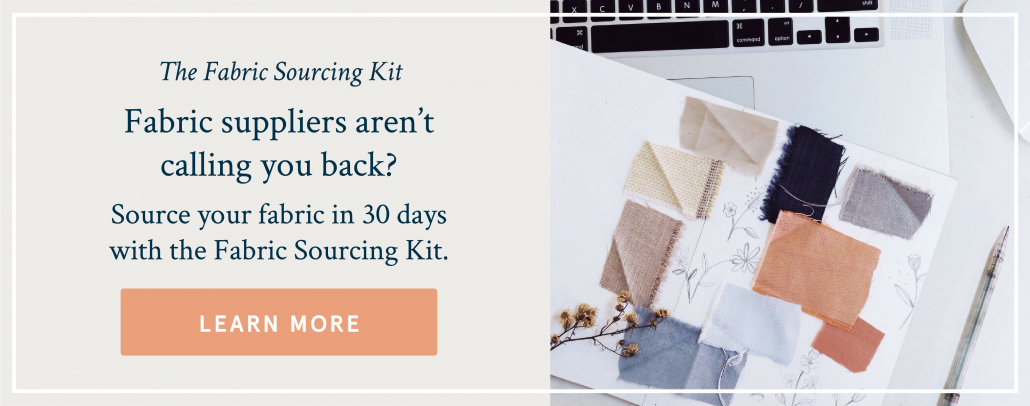Podcast Ep. 21: Effectively Negotiate Fabric Minimums with Suppliers
Listen on Apple Podcasts | Listen on Spotify
In your fabric sourcing journey, you will be faced with high minimums. You find the perfect fabric for your product, but the supplier says that fabric has an MOQ of 1,000 yards. Even if you haven’t worked out your exact quantities yet, you know that for your first collection 1000 yards is probably too high. Does that mean the dream of using this fabric is dead? Not necessarily. In today’s episode, I’m teaching you how to negotiate minimums with fabric suppliers.
Resources mentioned in this episode:
TRANSCRIPT
In your fabric sourcing journey, as you’re building your fashion brand you will run into being faced with high minimums and you’ll want to know some of the scenarios to negotiate.
Before we get into the main topic, I want to just go over a few of the seven key rules to remember when reaching out to fabric suppliers. If you want to grab a google doc or your journal notebook anything you can go ahead and jot these down.
When it comes to reaching out to fabric suppliers, I want you to first consider the audience you’re reaching out to. Whether that is email or phone, the supplier is likely receiving hundreds of requests per week, so you want to make sure that your inquiry gets straight to the point, whether that is an email or a phone call.
In 99 of cases the supplier does not care about your background or the mission of your company or all the other things that you probably really care about right at the end of the day they’re being pulled in all directions their job is to make a sale – so number two is to remember to keep your email inquiry short and sweet. If you’re on the phone, keep your conversation short and sweet. Get right to the point.
Number 3: do your due diligence. Make sure you do your own research on the supplier’s website before you reach out. Oftentimes you can get many of your questions answered on the suppliers about page, the shop page, maybe the faq pages… take a look! Ten years ago there wasn’t the inventory of fabric options online that there is today. Many suppliers have cataloged a lot of the fabrics they sell and they have set up these whole online ordering systems – even for swatches – so before reaching out to a supplier, check the website to make sure you’re not missing anything, especially as you get on the phone or via email and start building the relationship.
Step number four: They are going to want to see that you actually know what you’re talking about. They don’t want to have to answer all your questions or educate you. They also don’t want to risk their own time, so one great way to show that you’re serious about being their customer is to send over a design, a spec sheet or you could even send a visual example or an image of the piece you’re needing the fabric for. They’re not going to rip off or steal your design *I promise* the benefit of doing this means that even if the supplier, let’s say, doesn’t have what you’re asking for, they may be able to suggest some other fabric options that they do have because they have a better idea of what kind of product you’re trying to create from the fabric they’re sourcing.
Step number five, don’t ask about MOQs – or I should say rule number five. I’m not a big rules person, but it is a rule. Number five, don’t ask about MOQs – especially not in your first email. This mistake will probably make you come off as overly frugal or price conscious before even making initial contact. Yes of course you need to know this information for your own planning, but again in the first email or the first phone call, don’t ask.
Rule number 6: Foster the relationship so once you’ve received an initial response, take your time in building a relationship with the sales rep. I can’t emphasize this enough, you know you want to be courteous of their time, but you do want to cultivate the relationship and you want to make it easy for them to help you down the road. They’ll be so much more likely to negotiate MOQ’s with you – which we’ll obviously get into in a lot more detail in just a minute.
Last rule: stay persistent. Be mindful of not overwhelming the supplier, but don’t give up. Finding sustainable and low impact fabrics is not an easy task for anyone. I’ve been through it all. I watch my entrepreneurs go through it. I help them through it, but it’s so important to stick to your values, to keep up your search. Fabric sourcing is just one of those steps in the product development process that takes the longest, so be patient and be persistent.
Okay so hopefully that painted a bit of a quick picture of how to initially reach out to fabric suppliers, and you know what to do and what not to do, but what happens, let’s say, when you find the perfect fabric for your product or collection, it has the perfect drape, the perfect weight, it’s made from the perfect fiber, it’s 100% the fabric you know you want to use…
Until the supplier says that fabric has a minimum order quantity of a thousand yards, and even if you haven’t worked out your exact quantities yet, you probably know that for your first collection a thousand yards is probably too high. You’re looking for let’s say more like 250 yards. Does that mean the dream of using this fabric is dead? Not necessarily. The thing is, it’s pretty common for fabric suppliers to require a minimum order quantity of 1000 yards or more, that’s kind of industry standard.
So, what do you do?
The first thing is to find out why the minimums are set at the amount that they are. This is the first thing you want to keep in mind, that the exact reasons will be specific to the individual suppliers, so once you find out their why, you’ll be better equipped to negotiate. You need to know why that rule is in place so that you can basically devise a plan.
Here’s scenario number one: There is a set MOQ for custom dyeing. So if you want to custom dye, when a supplier sets an moq because of time efficiency for custom dyeing your fabric, you can offer to pay a flat dye fee in addition to the per yard cost of the fabric, so this may add to the final cost of your order, but it will likely be much cheaper than ordering, let’s say, three times the amount of fabric you need just to meet the MOQ. I would much rather pay that extra flat fee than just be overwhelmed with fabric that I can’t even use.
Scenario number 2 is that the MOQ is in place because it costs what it costs. So if the MOQ is in place because it costs what it costs, and the supplier just isn’t willing to budge then you can try 2 things. You can offer to put down a deposit but place smaller orders at a time in a payment plan of sorts, or you can see if there’s an option of piggybacking onto one of their existing clients orders and splitting the cost. Keep in mind that for piggybacking to work, your production schedule will need to be flexible. You’re basically depending on another one of their clients’ orders, so you have to be a little flexible with when you’ll need the fabric.
When I had my clothing brand in 2011, this is what my then Co-founder and I did to meet the MOQ’s for the fabric we wanted to use. We were limited to the colors we got to choose because the other client obviously got to choose them, they were putting in the bulk massive order, but for us it was kind of like a small consolation for being able to use our perfect fabric. It just wasn’t hugely important that we got to choose the colors. We were much more interested in being able to use that fabric. So if you’re looking for more guidance on how to initially reach out to fabric suppliers I’ve talked about this and the fabrics they carry, I have free email templates I’ve put together for you.
Scenario number three: The MOQ is in place because it’s a custom order. If the MOQ is in place because it’s a custom order it may be worth conceding to what the supplier already has available in their warehouse or in stock. If you can meet the minimums of an in-stock fabric that is a very different color, it’s probably worth settling for it.
This is also why I tell people in the beginning, try not to custom dye. Try not to be that specific in the colors because you’re just going to open yourself to many more options if you’re able to purchase in stock. Sometimes, you don’t want to be so committed to your original vision, that you can’t see the good enough version staring you in the face (especially when it can save you money).
Scenario number 4 is a standard negotiation tip. You’ve probably heard it before. You can try offering to pay a higher price per yard so in order to purchase less than their normal MOQ, you can offer to pay more per yard. This may be something that they actually already offer after they find out you can’t meet the MOQs, but if they don’t, this can be a last ditch effort. It’s worth just asking, but only if your margins can accommodate it.
The bottom line is when it comes to any type of negotiating, the success of the negotiation is based on the relationship you’ve built. This is why I’m always saying, over and over again, like a broken record, how important it is to build a relationship with your suppliers and your sales reps.
In most cases they want to be able to help you. It means a sale for them. You can make sure you’re an ideal client by being knowledgeable, courteous of their time, responsive and just generally putting in the time and effort.
So, as you get yourself in the game, you may learn that there are many ways you can go about negotiating. You may find that you have a supplier sales rep who is flexible and willing to work with you, and you just kind of have to find and choose what works best for your financial projections, your budget, all that good stuff. So go with your instincts, but don’t force it.
I will say, if a supplier absolutely won’t budge, then it’s just better to kind of cut your losses and find a different fabric as hard as that may be, rather than obviously burn a bridge.
Before we end the episode, I have one last thing for you as you begin reaching out to fabric suppliers to source your fabric. Make sure to check out our Fabric Sourcing Kit, which I’ll link to in the description – it features email templates that you can copy and paste to effectively reach out to suppliers, as well as a list of my top 10 fabric suppliers that sell sustainable fabrics and low minimums. People have told me that they weren’t getting any responses from suppliers until they started using this kit, so it’s definitely something you’ll want to have in your back pocket as you begin your fabric sourcing journey.



